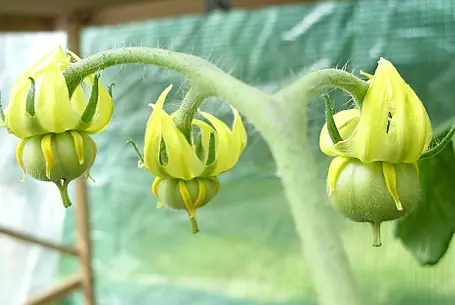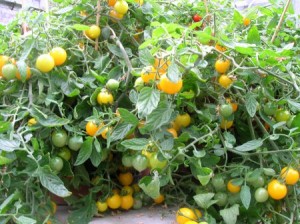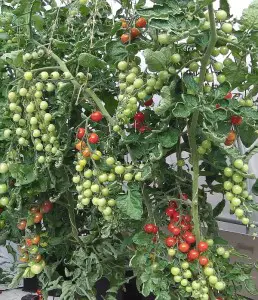When to remove the growing tip
Tomato plants have two stages of growth – the vegetative (growth) and the reproductive stage (fruiting).
Professional growers are aware of the fact that they need to encourage plants from one stage to the other and to keep a balance that will produce a good crop of tomatoes over a set period of time. This is done by nutrition and pruning to name but two methods.
The growing tip is the most “favoured” part of the tomato plant. It is able to take (mobile) nutrients from lower leaves if there is a shortage of nitrogen or magnesium for example. You will see this happen when the lower leaves turn pale green or yellow and upper leaves look perfectly healthy.
If we remove the growing tip before the first truss has set, that is, started to grow small tomatoes, we will be sending the nitrogen meant for cell growth of the growing tip, around the plant. This will keep the plant in the vegetative stage longer, producing leaves rather than fruit.

However, after the first truss has set, a small burst of nitrogen is beneficial. A plant won’t produce heavy leaf growth because the plant has already entered the fruiting stage or reproductive stage but will encourage further truss development higher up. This is particularly useful when growing large varieties that tend to run out of steam when they reach the third truss.
To sum up – when to remove the growing tip
It’s best not to remove the growing tip at least until after the first truss has set. You may have several trusses set before the growing tip needs to be removed, which is good, but the plant should be in the fruiting stage.
The number of trusses
I generally allow six or seven trusses on a tall cherry variety. Five or six on a medium variety and four or five trusses on a beefsteak variety. However, some varieties are more vigorous than others and that is relevant too.
Bush Varieties
I have to admit that I have a soft spot for growing bush varieties.
No pruning, little staking and among the first to mature are just some of their benefits.

Of course they do tend to mature over a shorter period than tall (cordon) varieties, but in a UK summer, we don’t get a very long fruiting period anyway!
There are many great bush varieties such as Red Alert, Maskotka, Legend, Oregon Spring and Black Sea Man – not forgetting the many “Tumbler” types. The quickest fruiting variety I’ve ever grown is Red Alert, with mature fruit by the end of May or beginning of June – if sown in February.
Pruning bush varieties
Although we don’t usually prune bush varieties, there are times when if a plant produces too many flower buds or clusters, we may decide to prune a few, in order to promote better growth of the flowers that have already set fruit.
When tall varieties are not pruned
Tall varieties are sometimes grown as bush varieties – by allowing all the side shoots to grow – creating a big untidy bush! The plant that holds the record for the most cherry tomatoes was grown this way.
In long season areas, this is a common practice and gardeners in these areas can’t understand why those in short season areas remove side shoots at all!
Quicker to ripen
However, like many things we do when growing tomatoes, pruning is done in order to bring fruit to maturity sooner – in a short season area like the UK, this is obviously important.
Feeding with tomato food high in potassium is also done to make tomatoes ripen more quickly before temperatures drop and the autumn chill begins.
The record breaker
It’s interesting to note that the record breaker tall variety, grown as a bush variety, was fed on a balanced vegetable feed. The average pack of tomato food, heavy in potassium, will encourage fruit to mature more quickly, but will also bring a plant to the end of its life cycle sooner. Given a long summer with plenty of time for fruit to ripen, a balanced feed may be more suitable and produce better results.
Feeding for boosting upper truss growth
- Feeding tomato food as soon as the fruit tomatoes appear on the first truss works OK for cherry varieties but if growing medium or beefsteak toms a balanced feed is better.
- When the first trust has set fruit, giving a balanced feed for a week or two (with more nitrogen than tomato food) will encourage the development of the upper trusses.

The season so far
It’s been a good season so far in the UK, with few reports of stunted growth, leaf curl, tomatoes maturing before they reach full size and fewer fruit on trusses to name but a few issues that occur when the weather is very inconsistent.
Tomato plants like consistent conditions so when we get wide variation in temperatures, wet/dry conditions etc., we get plants behaving badly!
I hope yours are on their best behaviour!
Regards,
Nick

Margaret Horton
Can you tell me what the long long strands on my tomato plants are. No one has ever seen that. They have a small leaf at the ends.some of them 2ft Please help. Thank you
Nick
Hi Margaret, I would need to see a photo to be able to help.
Anonymous
tyt
Nick
Pinch out growing tip on tall varieties two leaf branches above top truss.
In a short season (UK) growing outside after four trusses. In greenhouse, allow five or six trusses.
David
My Moneymaker are doing quite well on the balcony but most of the 10 plants I have are suffering from an affection of the leaves that causes them to “bunch up” or curl up, rather like parsley. Could this be the result of the high temps we have had on a couple of occasions for a few days at a time, (30C+), this summer?
Three of my plants are growing in Grow Bag pots, I bought some years ago, on a growbag. The other 6 plants are growing 3 to a growbag while the last is in a tub. Most of the plants have small fruit which seems to be growing normally.
As always, Nick, I enjoy reading your newsletter on a Saturday & I find the tips are always interesting.
Nick
Hi David, It sounds as if the plants have become stressed because of high temperatures as you suggest. The only way to cope when temps are high is to use a Quadgrow planter or Autopot system. Having water available 24/7 really does help protect plants from all sorts of stress problems and BER.
Rhys Jaggar
First fresh tomato soup of the season cooked today with 1lb of ripe Maskotkas. Pinching tips out of many plants this week as enough fruit are set/growing.
This is one of the earliest I have ever done it, thanks to all the warm sunshine the past 8 weeks.
I must say that growing bush cherry varieties does seem the simplest and most reliable way of cropping tomatoes…….
Nick
Hi Rhys, I haven’t grown Maskotka for some seasons, but it is going to be top of my list for next season – I can taste that tomato soup from here!
Robert Smith
Hi Nick, always look forward to your newsletter on a Saturday, truly a mine of information, my plants seem to be coming along very nicely i’m pleased to say, although I can see the fruits beginning to change colour now they seem to have been very slow to ripen, I think this has been my own fault as quite early on in the season I fitted shading and for various reasons didn’t remove it until a couple of weeks ago.
The weather here in South Queensferry on average has been generally lacking in sunlight over a fairly long period, no prolonged spells of sunshine so that hasn’t helped matters. Not to worry though, as I say I can see signs of ripening now and hopefully will begin pulling soon.
Many thanks again Nick, keep up the good work.
Nick
Hi Robert, I’m pleased that you enjoy the Newsletters – I’ve got a number of tall varieties that are only just beginning to ripen. This season the bush varieties were way ahead in my part of the world (Devon), namely Tumbler, Red Alert and Balconi Red. Of the tall toms Sungold, closely followed by Mountain Magic are on the table but Brandywine has still a long way to go!
Brian C.
I wish that you had included this info a bit earlier in the season. I am already stopping my growing tips. Is it too late to use a more balanced fertiliser?
Nick
It’s not too late.
Sharon
Thanks for the very informative post, Nick. I love the picture of the tomatoes just starting to appear. Happy to say I’m having a very good season so far. Early Black Krim tomatoes fantastic!
Nick
Hi Sharon, I grew Black Krim a couple of seasons ago – one of the juiciest and fine tasting toms I’ve tasted!
Anonymous
Thanks Nick.
Always interesting to read your letters.
Don
Nick
Thanks Don!